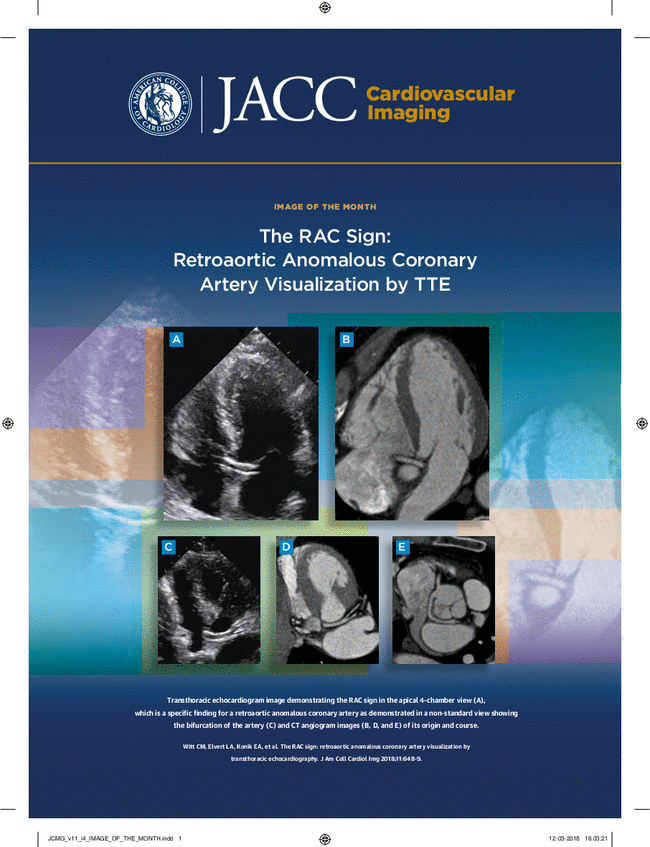Ultrasonic Texture Analysis for Predicting Acute Myocardial Infarction.
IF 15.2
1区 医学
Q1 CARDIAC & CARDIOVASCULAR SYSTEMS
引用次数: 0
Abstract
BACKGROUND Acute myocardial infarction (MI) alters cardiomyocyte geometry and architecture, leading to changes in the acoustic properties of the myocardium. OBJECTIVES This study examines ultrasomics-a novel cardiac ultrasound-based radiomics technique to extract high-throughput pixel-level information from images-for identifying ultrasonic texture and morphologic changes associated with infarcted myocardium. METHODS We included 684 participants from multisource data: a) a retrospective single-center matched case-control dataset, b) a prospective multicenter matched clinical trial dataset, and c) an open-source international and multivendor dataset. Handcrafted and deep transfer learning-based ultrasomics features from 2- and 4-chamber echocardiographic views were used to train machine learning (ML) models with the use of leave-one-source-out cross-validation for external validation. RESULTS The ML model showed a higher AUC than transfer learning-based deep features in identifying MI [AUCs: 0.87 [95% CI: 0.84-0.89] vs 0.74 [95% CI: 0.70-0.77]; P < 0.0001]. ML probability was an independent predictor of MI even after adjusting for conventional echocardiographic parameters [adjusted OR: 1.03 [95% CI: 1.01-1.05]; P < 0.0001]. ML probability showed diagnostic value in differentiating acute MI, even in the presence of myocardial dysfunction (averaged longitudinal strain [LS] <16%) (AUC: 0.84 [95% CI: 0.77-0.89]). In addition, combining averaged LS with ML probability significantly improved predictive performance compared with LS alone (AUCs: 0.86 [95% CI: 0.80-0.91] vs 0.80 [95% CI: 0.72-0.87]; P = 0.02). Visualization of ultrasomics features with the use of a Manhattan plot discriminated infarcted and noninfarcted segments (P < 0.001) and facilitated parametric visualization of infarcted myocardium. CONCLUSIONS This study demonstrates the potential of cardiac ultrasomics to distinguish healthy from infarcted myocardium and highlights the need for validation in diverse populations to define its role and incremental value in myocardial tissue characterization beyond conventional echocardiography.超声织构分析预测急性心肌梗死。
背景:急性心肌梗死(MI)会改变心肌细胞的几何形状和结构,导致心肌声学特性的改变。目的:本研究探讨超声组学——一种基于心脏超声的新型放射组学技术,用于从图像中提取高通量像素级信息——用于识别与梗死心肌相关的超声纹理和形态学变化。方法我们纳入了684名来自多源数据的参与者:a)回顾性单中心匹配病例对照数据集,b)前瞻性多中心匹配临床试验数据集,以及c)开源国际和多供应商数据集。从2室和4室超声心动图视图中使用手工制作和基于深度迁移学习的超声组学特征来训练机器学习(ML)模型,并使用留一源交叉验证进行外部验证。结果ML模型识别MI的AUC高于基于迁移学习的深度特征[AUC: 0.87 [95% CI: 0.84-0.89] vs . 0.74 [95% CI: 0.70-0.77];P < 0.0001]。即使在调整常规超声心动图参数后,ML概率仍是心肌梗死的独立预测因子[调整OR: 1.03 [95% CI: 1.01-1.05];P < 0.0001]。即使存在心肌功能障碍(平均纵向应变[LS] <16%) (AUC: 0.84 [95% CI: 0.77-0.89]), ML概率对鉴别急性心肌梗死也有诊断价值。此外,与单独LS相比,将平均LS与ML概率相结合显著提高了预测性能(auc: 0.86 [95% CI: 0.80-0.91] vs 0.80 [95% CI: 0.72-0.87];P = 0.02)。使用曼哈顿图对超声组学特征进行可视化,可区分梗死段和非梗死段(P < 0.001),并有助于对梗死心肌进行参数化可视化。结论:本研究证明了心脏超声组学在区分健康心肌和梗死心肌方面的潜力,并强调需要在不同人群中进行验证,以确定其在常规超声心动图之外的心肌组织特征中的作用和增加价值。
本文章由计算机程序翻译,如有差异,请以英文原文为准。
求助全文
约1分钟内获得全文
求助全文
来源期刊

JACC. Cardiovascular imaging
CARDIAC & CARDIOVASCULAR SYSTEMS-RADIOLOGY, NUCLEAR MEDICINE & MEDICAL IMAGING
CiteScore
24.90
自引率
5.70%
发文量
330
审稿时长
4-8 weeks
期刊介绍:
JACC: Cardiovascular Imaging, part of the prestigious Journal of the American College of Cardiology (JACC) family, offers readers a comprehensive perspective on all aspects of cardiovascular imaging. This specialist journal covers original clinical research on both non-invasive and invasive imaging techniques, including echocardiography, CT, CMR, nuclear, optical imaging, and cine-angiography.
JACC. Cardiovascular imaging highlights advances in basic science and molecular imaging that are expected to significantly impact clinical practice in the next decade. This influence encompasses improvements in diagnostic performance, enhanced understanding of the pathogenetic basis of diseases, and advancements in therapy.
In addition to cutting-edge research,the content of JACC: Cardiovascular Imaging emphasizes practical aspects for the practicing cardiologist, including advocacy and practice management.The journal also features state-of-the-art reviews, ensuring a well-rounded and insightful resource for professionals in the field of cardiovascular imaging.
 求助内容:
求助内容: 应助结果提醒方式:
应助结果提醒方式:


